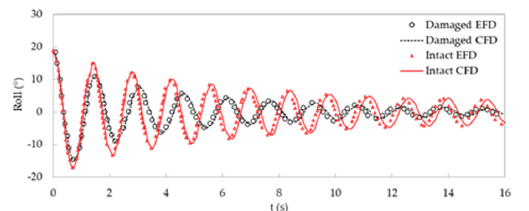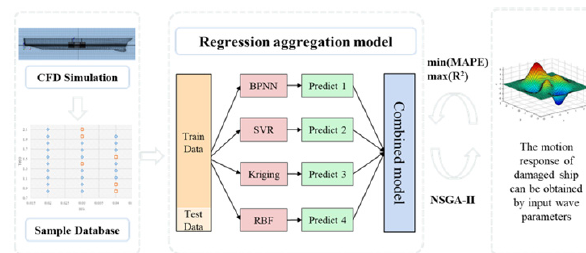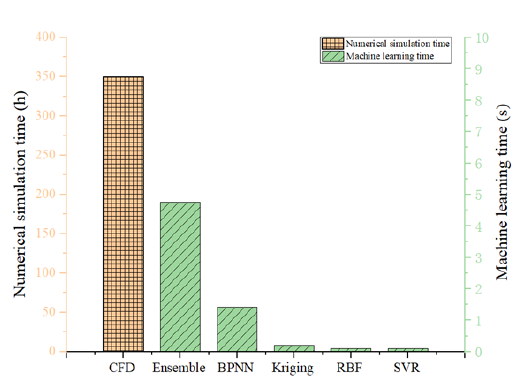- Submissions

Full Text
Examines in Marine Biology & Oceanography
Fast Prediction for Damaged Ship Roll Motion in Waves by an Aggregation Model based on GA
Xinran Liu and Tingqiu Li*
School of Naval Architecture, Ocean and Energy Power Engineering, China
*Corresponding author: Tingqiu Li, School of Naval Architecture, Ocean and Energy Power Engineering, 1040 Peace Avenue, Wuhan 430063, China
Submission: January 19, 2023;Published: January 31, 2023

ISSN 2578-031X Volume5 Issue3
Abstract
In this paper, we discuss one typical case of the standard damaged DTMB5415 using CFD (Computational Fluid Dynamics) with a fast multigrid technique combined with a regression aggregation model, which could achieve fast prediction of the damaged ship roll motion in waves. The relevant regression aggregation model consists of a Back Propagation Neural Network (BPNN), Radial Basis Function (RBF), Support Vector Regression (SVR), and the Kriging model. By constructing the regression aggregation model with the two-parameter input (the environmental variables like wave steepness δ and period T) and one output (the system’s dynamic response), the predicted value is well compared with the CFD value that can verify the universality and feasibility of the aggregation model. In particular, the Genetic Algorithm (GA) can coordinate the generalization performance of every single model and has universality while guaranteeing high prediction accuracy. This study provides a reference for selecting the prediction models of ship motion response.
Keywords: CFD; Fast multigrid technique; Regression aggregation model; Fast prediction of damaged ship motions in waves
Introduction
Generally, a numerical simulation with CFD requires significant CPU time, especially for damaged ship motions in waves. As in this case, the fluid-solid coupling trends to be strong nonlinear. In recent years, one potential approach has been combining the advanced CFD technique with machine learning, which helps improve computations’ efficiency. Additionally, with the development of computer network technology, machine learning techniques have gained great momentum in the shipping industry by their powerful ability to learn hidden features [1,2]. However, the problem of motion response prediction for damaged ships is rarely discussed. This study applies machine learning to predict ship motion response based on the damaged standard DTMB5415 [3,4]. The evaluating estimator performance is adopted to ensure the accuracy and stability of model prediction. In this study, Mean Absolute Percentage Error (MAPE) and the coefficient of determination R2 are chosen as the model evaluation indicators.
An Aggregation Model for Damaged Ship Roll Motion Prediction
Based on the benchmark cases of experimental and numerical simulations in existing papers [5,6], the motion of the DTMB 5415 double hull broken ship model under different wave parameters is investigated. It is necessary to consider that the liquid flow in the open compartment is highly turbulent, with broken waves and other viscous flow phenomena, which is theoretically a complex nonlinear non-constant flow problem. Figure 1 shows the numerical simulation domain of damaged ships in transverse waves. As shown in Figure 2, the ship roll attenuated motion after the damage is compared with that in intact condition. Breakage in midship has a great influence on ship roll motion. The natural roll period of the damaged ship is 1.57s, which is significantly larger than that of the intact ship. The results show that the numerical solutions agree well with the experimental data, and the relative error is controlled within 5%, which can provide reliable training samples for the subsequent construction of the damaged ship motion proxy model.
Figure 1:Computational domain for numerical simulation of the damaged ship.

Figure 2:Comparison of the experiment and numerical results.

Discussion
Through the data pre-processing technique, an aggregation model with two input vectors (wave steepness δ and period T) and an output vector (the roll decay motion) is established to realize fast prediction of ship motion response amplitude in waves. In this case, the linear weighted combination of four single models was constructed by GA. The relevant regression aggregation model consists of a Back Propagation Neural Network (BPNN), Radial Basis Function (RBF), Support Vector Regression (SVR), and the Kriging model. The training process is shown in Figure 3. The performance of each model on the six groups of test data is shown in Table 1. Compared with the four single models, the results of the aggregation model are in good agreement with those of CFD numerical simulation. The MAPE of the regression aggregation model is only 8%, and the coefficient of determination is 0.9739, which shows higher accuracy and stability. In terms of rapidity, the genetic algorithm-based aggregation model approach strategy can accurately predict the amplitude of the transverse rocking motion response of the damaged ship model, and the total time is at least one order of magnitude less than the CFD numerical simulation (Figure 4).
Figure 3:Scheme of the aggregation model.

Figure 4:Comparison of time-cost between single/ensemble model & CFD.

Table 1: Comparison of the performance of forecasting models.

Conclusions
Although the optimization algorithm also consumes some time cost, it is obvious that the aggregation model has better strength and prediction ability in the face of complex samples and uncertainty in engineering practice. At the same time, the case further verified the potential of machine learning to predict complex nonlinear nonconstant flows.
Acknowledgement
This project was supported by the Major International Joint Research Program of China (Grant NO.51720105011), the Foundation of China (No. 61402070105), the Major Project (No. SXHXGZ-SCJ-2020-2).
References
- Chen AG, Ye JW (2010) Research of three layers backpropagation neural network on ship resistance computation. Ship Building of China 2: 21-27.
- Kai L, Yan L, Shang JZ (2011) Artificial neural network-based ship design and resistance prediction. Journal of Wuhan University of Technology 35(1): 29-32.
- Han-Bing S, Yang SQ, Xu YF, Xiao JF (2022) Prediction of the pitch and heave motions in regular waves of the DTMB 5415 ship using CFD and MMG. Journal of Marine Science and Engineering 10(10): 1358.
- Hu L, Wu H, Yuan Z, Li W, Wang X (2021) Roll motion response analysis of damaged ships in beam waves. Ocean Eng 227:
- Begovic E, Day AH, Incecik A (2017) An experimental study of hull girder loads on an intact and damaged naval ship. Ocean Engineering 133: 47-65.
- Begovic E, Mortola G, Incecik A, Day AH (2013) Experimental assessment of intact and damaged ship motions in head, beam and quartering seas. Ocean Engineering 72: 209-226.
© 2023 Tingqiu Li. This is an open access article distributed under the terms of the Creative Commons Attribution License , which permits unrestricted use, distribution, and build upon your work non-commercially.
 a Creative Commons Attribution 4.0 International License. Based on a work at www.crimsonpublishers.com.
Best viewed in
a Creative Commons Attribution 4.0 International License. Based on a work at www.crimsonpublishers.com.
Best viewed in 







.jpg)






























 Editorial Board Registrations
Editorial Board Registrations Submit your Article
Submit your Article Refer a Friend
Refer a Friend Advertise With Us
Advertise With Us
.jpg)






.jpg)














.bmp)
.jpg)
.png)
.jpg)










.jpg)






.png)

.png)



.png)






